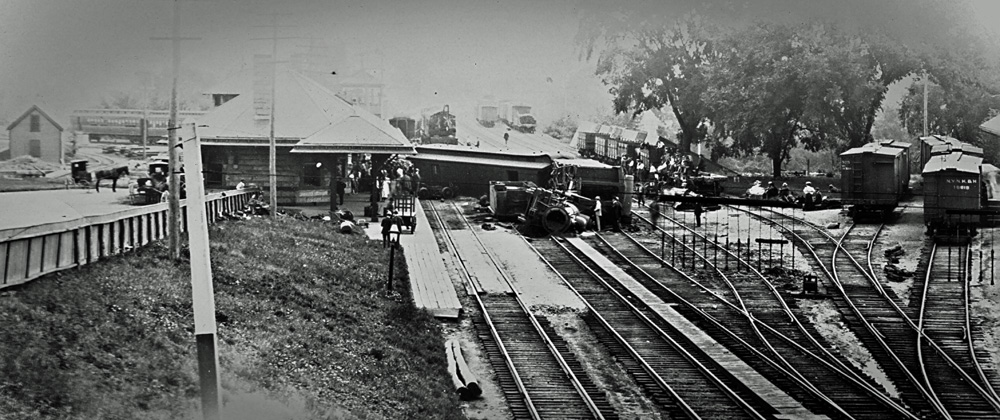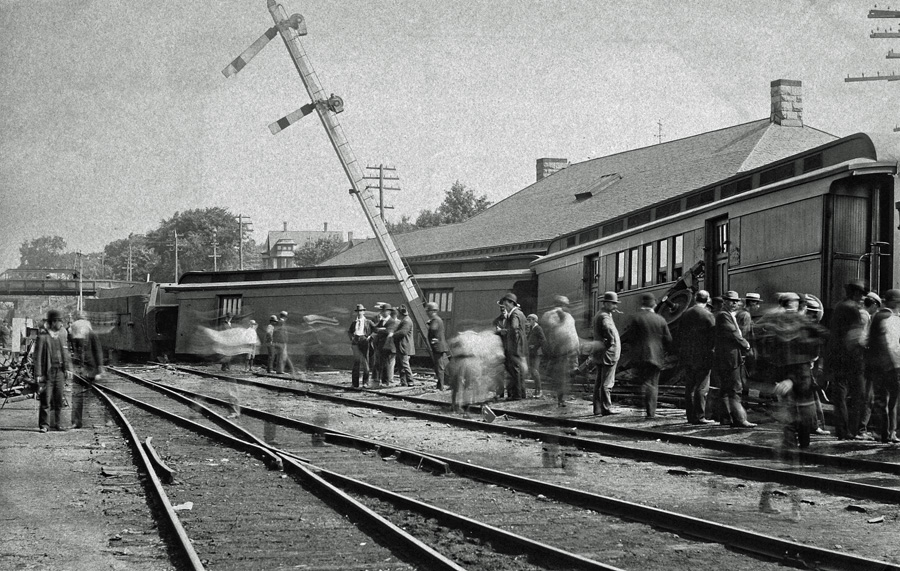True Tales from Canton’s Past: Death on the Rail
By George T. Comeau
Looking south from the Spaulding Street Bridge at the wreckage of the Boston-bound postal train, which claimed three lives in 1898. (Courtesy of the Canton Historical Society)
This story originally appeared in the Canton Citizen on November 3, 2011 and was reprinted in this week’s edition. ~
Just about every day since 1834, for more than 177 years, trains have been part of Canton’s landscape. The sounds of bells gave way to horns, and smells of coal have given way to diesel. Canton figures prominently in American railway history. One of the first lines in the country was laid out between Boston and Providence, and history rumbled through our town on steel rails.
There have been many railway accidents along the line that passes through our town. Perhaps the most tragic occurred in 1898. The early morning of Monday, August 8, was just as ordinary as any other. Canton was an industrial town, and the sounds of an early morning would have been punctuated by factory whistles, bells, yards full of chickens — all a backdrop to dawn. Rising early, residents began their day with morning rituals that were interrupted by a thunderous sound that mismatched any of the normal backdrops.
The crash occurred at the intersection where the Stoughton Branch intersected with the main line of the New York, New Haven and Hartford Railroad. At 5:10 a.m. the Boston-bound mail train consisting of a locomotive and four mail-sorting cars rushed across the Viaduct, and moments later it sliced into a faulty rail switch. The sound, by all accounts, was thunderous as several tons of steel instantaneously dug into the ground at Canton Junction. Within moments, firebox 93 struck the alarm and rescuers were summoned. Hundreds of residents flocked to the scene of devastation.
Mail trains would leave New York full of bags and parcels, and along the route men would sort the mailbags and prepare the shipment for delivery once the daily train arrived in Boston. The train would leave New York City at 11:30 p.m. and would take about six hours to get to Boston’s South Station, where the mail would be transferred. The train consisted of a locomotive and several sorting cars that were like rolling rooms complete with sorting tables. On August 8 there were 17 men aboard Train No. 70.
The local papers reported the story, and the New York Times picked it up and ran the full account: “The morning was clear and when crossing the Viaduct engineer Sheldon could easily discern the signals, which indicated a clear track. Apparently there was no warning to the doomed men. As a rule with a clear track express trains slide over the bridge at 15 to 20 miles an hour and on reaching the straight track the throttle is opened and by the time the depot was reached the speed is practically doubled. This appears to have been the case this morning. It seems doubtful if steam was shut off before the switch was reached. Those in the cars felt no application of brakes and the few lookers-on were too horrified by the sudden catastrophe to be able to recollect just what was the condition at the moment the engine left the rails.”
The speed at which the train was traveling when it crashed was estimated to be about 40 miles per hour. The Canton Viaduct was constructed such that it has a one-degree curve at the track bed, just slight enough that speeds would be reduced to compensate for the lean that would be required when managing the curve. Several years ago a new deck was installed on top of the structure, and today’s modern Acella service actually tilts into the curve to compensate for the alignment needed to reach speeds of 80-100 miles per hour.

A photo taken at the crash scene credited to Frederick Endicott of the Kanton Kamera Klub. (Courtesy of the Canton Historical Society)
As No. 70 ramped up its speed, it would be less than a quarter of a mile at a downgrade to the spot where it crashed. The newspapers reported that the “rails turned the locomotive from the straight track and the momentum being too great to allow the heavy machine to be so abruptly turned from its course, it plunged diagonally across the switch and dived like an immense plow into the space between the tracks. The road bed was excavated to the depth of a yard for some 50 feet, the planking in front of the baggage-room carried away, and leaving the forward truck in front of the depot, the machine fell on its side and with well nigh everything stripped from boiler and frame, lay blowing off steam just north of the depot on the outbound track. The first car of the train followed the engine till its fall, when it also turned on its side, falling over on the turn-out west of the outbound track and slid by the tender cutting off the top of the cab and catching one of the unfortunate men on the engine under its forward end, crushed him into the ground beneath it. The other two men were found beneath the ruined cab. In this car were five mail clerks, who were thrown around, to use the expression of one of them, ‘like dice in a box.’ All were more or less injured and their wounds being temporarily dressed were taken to Boston on a train at 6:30 a.m. to the hospital, where they were attended to and with the exception of Buckland sent home. The latter remained at the hospital, but is not thought to be dangerously hurt.”
The train was totally destroyed, “the trucks of all the cars, the gas tanks, brake cylinders and all the rigging underneath the cars stuck in the trench dug by the locomotive in front of the baggage door and only the forward locomotive truck passed that spot. The second car laid right side up diagonally across the three tracks, while the third formed almost a right angle with it, the front end lifted high on the wrecked trucks lacking only a few inches of driving into the shelter roof of the station. The fourth car alone remained on its trucks, but the forward one was broken to such an extent as to require heavy chains to hold it together and was terribly strained. The track and interlocking signals were torn up and scattered in every direction.”
This was a horrific crash. Three men died that day at the scene; the news accounts seem to suggest that they were alive when rescuers arrived but that little could be done to save them from the crushed steel that entombed them. The engineer, James Sheldon, the fireman, G. Knowlton, and James Schufeldt, a second engineer who had joined the train in Mansfield, were pronounced dead as a result of the crash. It would be several hours before these men were dug out and removed by the medical examiner and a local undertaker.
The interest in the crash continued into the night as all traffic on the rail line was routed through the freight yard while a steam derrick was brought in to clear the mangled wreckage. It would take workers until the next morning to complete the task of clearing and repairing the site. Trains waited on each end of the crash, and passenger traffic on the branch line had to walk around the crash to rejoin the waiting train. Many people pointed out the fact that the death toll would most certainly have been higher if this had been a passenger train instead of the postal express.
The crash was duly investigated and a faulty switch was discovered at the point where the Stoughton Branch joins the main line. Railroad historian Ed Galvin devoted a full chapter in his book, A History of Canton Junction, which he published in 1987. Galvin’s book features additional photographs and a complete discussion of this fatal accident.
The Canton Journal remarked upon the huge number of people who came to view the “ruins” and observed several “cameras” in evidence. The photographs that accompany this story were most likely taken by Fred Endicott or W. Ames, both of whom were there that day and were members of the Kanton Kamera Klub. These photographs are the first documented images of a train accident at Canton Junction.
Short URL: https://www.thecantoncitizen.com/?p=9319










